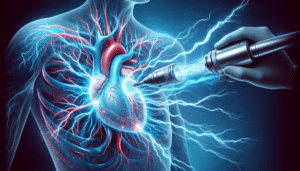Learn more about Sotalol in the treatment of AFib. Atrial Fibrillation, also known as AFib, is the most commonly diagnosed arrhythmia across the world. There is an increased risk of stroke, blood clot formation, and even risk for heart failure with this condition.
Under normal circumstances, the contractions and relaxations of the heart occur in a regular rhythmic fashion. However, in atrial fibrillation, as the name tells, the upper chambers of the heart called the atria beat haphazardly, which is often described as quivering. This disturbs the regular pumping of blood from the upper chambers to the lower chambers of the heart and throughout the body. Atrial fibrillation can frequently cause disabling symptoms of heart racing, chest pain, or shortness of breath.
If you or a loved one has been diagnosed with atrial fibrillation, understanding the pros and cons of various treatment options in essential for long-term management.
In this article, I will discuss Sotalol, a commonly used anti-arrhythmic medication for the treatment of atrial fibrillation. Here I will discuss the way Sotalol treats atrial fibrillation, as well as discuss common and more serious side effects.
What Is Sotalol?
Sotalol is an antiarrhythmic medication that can be acquired by prescription. It functions as a beta-blocker but also exhibits potassium channel blocking potential. Due to these effects, it is categorized as a Class III Antiarrhythmic Medication.
Although it was developed in 1960, Sotalol got approved in October 1992 for use as a tablet. As of now, it is available in tablet, oral solution, as well as intravenous forms for hospital use; however, the oral tablet form is what is most commonly used.
Sotalol’s indicated use is in atrial fibrillation and ventricular arrhythmia. It can also be found in its generic version as well as under brand names like Betapace, Sorine. Co-Sotalol, Linsotalol, etc.
What Does Sotalol Do?
Sotalol inhibits the beta receptors and the rapid potassium channels of the heart. This decreases repolarization of the heart muscle, increases the duration of the QT interval, and slows down and shortens the response to certain nerve impulses, particularly in the heart.
Simply put, Sotalol slows down the heart rate through various mechanisms so that your heart can pump blood throughout your body. As a result, abnormal heart rhythms such as atrial fibrillation are reduced.
How Much Sotalol Should I Take?
Sotalol comes in three strengths; 80 mg, 120 mg, and 160 mg. For adults aged 18 years and above, the recommended initial dose is 80 mg twice a day, which can be adjusted by doctors according to the patient’s individual needs.
The dose of Sotalol depends on several factors. These include your age, the severity of your condition, the form of Sotalol given (oral or I/V), your kidney function, as well as other underlying health comorbidities that you may have.
Sotalol is primarily cleared by a person’s kidneys. As a result, patients with abnormal kidney function may build up elevated levels of this medication and increase the risk for serious side effects.
You should strictly abide by the prescribed dose and frequency of Sotalol by your doctor. Generally, doctors start with a low dose and gradually modify it according to the compatibility with your body and achievement of the desired outcomes.
What is the Difference Between Sotalol and Sotalol AF?
Per the manufacturer, Sotalol AF is indicated for the treatment of atrial fibrillation but not regular Sotalol. However, in my research, I cannot find a chemical difference between Sotalol and Sotalol AF. Most likely, Sotalol AF was created after Sotalol became generic to create a new labeling indication for Sotalol.
I have commonly used Sotalol as well as Sotalol AF for my patients. Both versions are available as a generic.
What Are The Side Effects Of Sotalol?
Like any other drug, Sotalol also has certain side effects. The more common side effects of Sotalol are as follows:
-
Reduced heart rate
-
Drowsiness
-
Nausea
-
Vomiting
-
Headache
-
Diarrhea
-
Sleep disturbances
-
Lightheadedness or faintness
-
Confusion
-
Anxiety and depression
-
Weakness
These side effects are generally mild and will fade away on their own within a couple of days or weeks. However, if the symptoms persist for too long or become worse over time, please consult your doctor.
Fortunately, in most cases Sotalol does not cause a significant decrease in blood pressure during use, especially when compared to other commonly used beat-blocker medications. As a result, I have used Sotalol several times in patients with borderline low blood pressure.
Sotalol should also not be used in patients with congestive heart failure due to risk of worsening heart failure symptoms with the medication.
The Dangerous Side Effects Of Sotalol On Your Heart
Sotalol affects the heart’s rhythm and can lead to a condition in which QT prolongation is seen on the electrocardiogram. Simply put, the QT interval on an ECG is the time for a heart to reset after a single heartbeat. A prolonged QT means it is taking longer then normal for the heart to reset after a previous heartbeat. Torsades de pointes (twisting of peaks), is an extreme consequence of QT prolongation, which can sometimes occur when the heart rate is too slow and may lead to sudden cardiac death.
Although QT prolongation does not commonly cause a serious issue, it is a serious issue when it happens and is rarely fatal. It can cause a fast heartbeat, severe vertigo, fainting, and may require immediate medical attention. As a result, your doctor needs to monitor your ECG closely for evidence of QT prolongation if you are on Sotalol.
A few factors may increase your risk of QT prolongation. These include other comorbidities, simultaneous use of other drugs or supplements, and low magnesium or potassium levels in your blood. Reduced potassium and magnesium content can be observed with the use of certain drugs such as diuretics and lack of fluids in your body due to excessive sweating, diarrhea, or vomiting. Older adults and patients with underlying kidney disease are more susceptible to the serious side effects of Sotalol, including QT prolongation.
When giving a medical history to your healthcare provider, mentioning any or all prescription drugs and over the counter supplements is of utmost importance as a lack of comprehensive drug history may lead to increased risk for severe side effects due to Sotalol.
Alternative Medications to Sotalol
Alternative medications to Sotalol may include heart rate controlling medications or alternative anti-arrhythmic medications.
Heart Rate Control
Commonly used medications to control the heart rate are beta-blockers, calcium channel blockers, and digoxin.
Cardiac Rhythm Control
Alternative anti-arrhythmic may be an option for patients who do not tolerate Sotalol or if it is ineffective. Possible Alternatives include:
-
Amiodarone (Brand name Pacerone)
-
Propafenone
-
Dofetilide (Brand name Tikosyn)
Every anti-arrhythmic medication listed above has pros, cons, and risks for serious side effects. Although anti-arrhythmic medications are stronger to suppress atrial fibrillation compared to rate controlling medications, they have a higher risk for side effects and need to be monitored closely.
To read more about Amiodarone, including common side effects, read my article here.
To read more about Flecainide, including common side effects, read my article here.
Improve AFib Symptoms With Less Medications: The Guide To Reverse Atrial Fibrillation Naturally
If you are interested in natural treatment options for atrial fibrillation and are highly motivated in improving your symptoms naturally, to reduce your need for medications or even procedures, then take a look at my one-of-a-kind, online educational program, Take Control Over AFib.
Lifestyle modifications and reducing inflammation are essential components of the long-term management of atrial fibrillation. Addressing the source cause of atrial fibrillation can lead to a significant benefit for most AFib patients. Targeted lifestyle modifications can reduce your symptoms, reduce your reliance on medications or procedures, and even improve the long-term success rate of procedures for AFib. However, most patients are not given instructions or tips on how to accomplish these essential lifestyle modifications in an AFib targeted style.
This is exactly why I created the Take Control Over AFib Program, to give people a step-by-step plan to improve and potentially reverse atrial fibrillation naturally.
Thinking about lifestyle modifications is easy, but putting in place a system to keep you committed to achieve real results takes time and dedication, and with my step-by-step plan, we can achieve powerful and long-lasting results together.
Learn More About The Take Control Over AFib Program Here
Which Drug Is The Best For You?
In conclusion, while there is an assortment of medication treatment options available, what best suits you can only be determined by your doctor.
Fortunately, as you can see, there are usually several options for the treatment of atrial fibrillation in regards to medications as well as procedures. Read more about AFib treatment options here.
Catheter ablation procedures may also be a good option for patients who cannot tolerate medications, read more about the details of a catheter ablation procedure here.
As always, please discuss with your doctor the best treatment option in your individual situation.
The Best Atrial Fibrillation Book
Your Complete Guide To AFib: The Essential Manual For Every Patient With Atrial Fibrillation
$15.95 (as of May 29, 2025 06:52 GMT -06:00 - More infoProduct prices and availability are accurate as of the date/time indicated and are subject to change. Any price and availability information displayed on [relevant Amazon Site(s), as applicable] at the time of purchase will apply to the purchase of this product.) The A to Z guide on everything you need to know about atrial fibrillation. Written by AFib expert Dr. Percy Morales MD. Over 120 pages of essential information on medications, procedures, and lifestyles modifications for AFib. Easy to read for every patient.
Shop AFib Products on Amazon
KardiaMobile 6-Lead Personal EKG Monitor – Six Views of The Heart – Detects AFib and Irregular Arrhythmias – Instant Results in 30 Seconds – Works with Most Smartphones - FSA/HSA Eligible
13% Off
KardiaMobile 1-Lead Personal EKG Monitor – Record EKGs at Home – Detects AFib and Irregular Arrhythmias – Instant Results in 30 Seconds – Easy to Use – Works with Most Smartphones - FSA/HSA Eligible
$79.00 (as of May 29, 2025 05:52 GMT -06:00 - More infoProduct prices and availability are accurate as of the date/time indicated and are subject to change. Any price and availability information displayed on [relevant Amazon Site(s), as applicable] at the time of purchase will apply to the purchase of this product.)
Apple Watch Series 9 [GPS 41mm] Smartwatch with Storm Blue Aluminum Case with Silver Sport Band M/L. Fitness Tracker, Blood Oxygen & ECG Apps, Always-On Retina Display
(as of May 29, 2025 06:52 GMT -06:00 - More infoProduct prices and availability are accurate as of the date/time indicated and are subject to change. Any price and availability information displayed on [relevant Amazon Site(s), as applicable] at the time of purchase will apply to the purchase of this product.)
Fitbit Sense 2 Advanced Health and Fitness Smartwatch with Tools to Manage Stress and Sleep, ECG App, SpO2, 24/7 Heart Rate and GPS, Shadow Grey/Graphite, One Size (S & L Bands Included)

OMRON 2-in-1 Upper Arm Blood Pressure Monitor & 1-Lead EKG Monitor - Clinically Validated Blood Pressure Arm Cuff & Machine - Use OMRON Connect App
18% Off
Samsung Galaxy Watch 6 44mm Bluetooth Smartwatch, Fitness Tracker, Personalized HR Zones, Advanced Sleep Coaching, Heart Monitor, BIA Sensor, Health Wellness Insights, Big Screen, US Version, Graphite
12% Off
Natural Rhythm Triple Calm Magnesium 150 mg - 120 Capsules – Magnesium Complex Compound Supplement with Magnesium Glycinate, Malate, and Taurate. Calming Blend for Promoting Rest and Relaxation.
$20.77 ($0.17 / Count) (as of May 29, 2025 05:52 GMT -06:00 - More infoProduct prices and availability are accurate as of the date/time indicated and are subject to change. Any price and availability information displayed on [relevant Amazon Site(s), as applicable] at the time of purchase will apply to the purchase of this product.)
Pure Encapsulations Magnesium (Glycinate) - Supplement to Support Stress Relief, Sleep, Heart Health, Nerves, Muscles, and Metabolism* - with Magnesium Glycinate - 180 Capsules
$44.60 ($0.25 / Count) (as of May 29, 2025 06:52 GMT -06:00 - More infoProduct prices and availability are accurate as of the date/time indicated and are subject to change. Any price and availability information displayed on [relevant Amazon Site(s), as applicable] at the time of purchase will apply to the purchase of this product.)















![Apple Watch Series 9 [GPS 41mm] Smartwatch with Storm Blue Aluminum Case with Silver Sport Band M/L. Fitness Tracker, Blood Oxygen & ECG Apps, Always-On Retina Display #1](https://m.media-amazon.com/images/I/311xwtp4mFL._SL100_.jpg)
![Apple Watch Series 9 [GPS 41mm] Smartwatch with Storm Blue Aluminum Case with Silver Sport Band M/L. Fitness Tracker, Blood Oxygen & ECG Apps, Always-On Retina Display #2](https://m.media-amazon.com/images/I/41j+8AaUGsL._SL100_.jpg)
![Apple Watch Series 9 [GPS 41mm] Smartwatch with Storm Blue Aluminum Case with Silver Sport Band M/L. Fitness Tracker, Blood Oxygen & ECG Apps, Always-On Retina Display #3](https://m.media-amazon.com/images/I/41jIyxZitnL._SL100_.jpg)
![Apple Watch Series 9 [GPS 41mm] Smartwatch with Storm Blue Aluminum Case with Silver Sport Band M/L. Fitness Tracker, Blood Oxygen & ECG Apps, Always-On Retina Display #4](https://m.media-amazon.com/images/I/41IpNJERjCL._SL100_.jpg)
![Apple Watch Series 9 [GPS 41mm] Smartwatch with Storm Blue Aluminum Case with Silver Sport Band M/L. Fitness Tracker, Blood Oxygen & ECG Apps, Always-On Retina Display #5](https://m.media-amazon.com/images/I/31o17yhfYpL._SL100_.jpg)






































